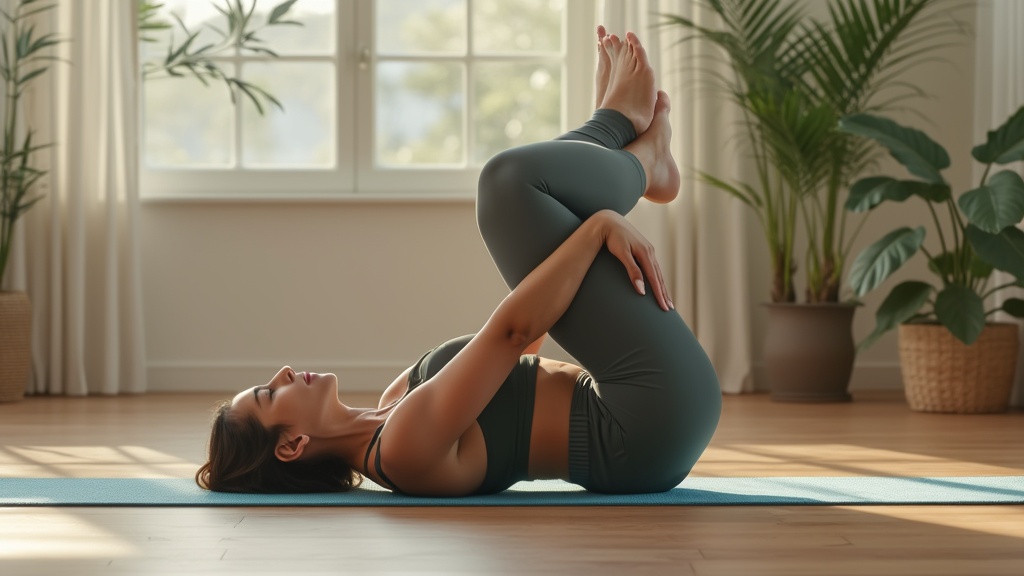
Incorporating gentle back stretching routines into your daily life can significantly enhance flexibility. These effective stretches not only help alleviate tension but also improve mobility and overall wellness.
Regular practice of gentle movements minimizes the risk of injury and enhances posture correction.
By dedicating just a few minutes each day to stretching, you can experience benefits that extend beyond flexibility, including stress reduction and muscle tension relief.
This article delves deeper into various gentle back stretches and their remarkable impact on physical health.
Gentle Back Stretching Exercises
Engaging in gentle back stretching exercises proves essential for alleviating tension caused by daily activities. Prolonged periods of sitting, coupled with common tasks, often lead to significant muscle tension.
These gentle stretching routines provide effective low-impact solutions, facilitating relief and enhancing mobility.
Benefits of Gentle Back Stretches
- Flexibility enhancement: Regularly performing gentle stretches increases the range of motion.
- Muscle recovery: These exercises promote healing and recovery from muscle fatigue.
- Posture improvement: Incorporating stretching into your routine assists in maintaining proper alignment.
- Tension alleviation: Gentle stretches help relieve accumulated stress and muscle tightness.
Practical Example of a Gentle Stretch
A practical example of a gentle stretch to try at home is the Child’s Pose. To perform this stretch, begin on your hands and knees. Then, sit back on your heels while reaching your arms forward. Hold this position for at least 30 seconds. Focus on deep breathing to further enhance relaxation and activate mindful movement, contributing to overall body awareness and tension alleviation.

Additional Gentle Yoga Practices for Back Pain
Incorporating gentle yoga for back pain into your routine can offer a holistic approach to wellness. These practices provide numerous health benefits, including enhancing spinal alignment and promoting body relaxation. Regular participation in these wellness routines fosters an improved sense of balance and eases movement throughout daily activities.
How Does Gentle Yoga Help Back Pain
Gentle yoga practices serve an essential function in alleviating back pain, particularly through enhancing flexibility, a key factor in maintaining overall spinal health. Improved flexibility not only contributes to discomfort prevention but also plays a role in muscle tension relief for those experiencing existing pain.
Techniques involving mindful breathing are integral to this process, as they promote relaxation and support effective pain management.
For instance, incorporating the Cat-Cow stretch into your routine significantly increases mobility, while concurrently supporting back health.
This particular pose encourages both the arching and rounding of the spine, thereby facilitating effective muscle tension relief and promoting improved posture.
Benefits Of Flexibility Routines For Back
Flexibility routines are fundamental to enhancing spine health, as they enable improved mobility and reduce the risk of injuries. Regularly practicing back stretching exercises, such as hamstring stretches and the Child’s pose, contributes significantly to posture improvement and the alleviation of stiffness.
Commitment to these exercises leads to considerable daily stretching benefits, ultimately enhancing ease of movement during everyday tasks. A recommended daily routine might include warmup stretches lasting approximately 10-15 minutes, emphasizing gradual flexibility enhancement that ensures long-term relief from back pain.
Gentle Yoga for Back Pain
- Gentle yoga enhances flexibility, which is crucial for maintaining spinal health and preventing discomfort.
- Mindful breathing techniques used in yoga promote relaxation, aiding in effective pain management.
- Regular back stretching exercises improve posture and alleviate stiffness, contributing to overall ease of movement.
- A daily routine of warmup stretches can lead to long-term relief from back pain and improved mobility.
Importance Of Spine Health In Stretching
Spine health significantly impacts overall wellness, as poor spinal alignment can lead to discomfort and limited mobility. Regular stretching plays a key role in enhancing spinal alignment, thereby helping to alleviate tension and promote flexibility.
Incorporating spine-focused stretches such as the cat-cow pose and seated spinal twist can significantly improve spinal function.
These gentle movements foster muscle tension relief and enhance body awareness, ultimately leading to better posture.
To seamlessly integrate these stretches into your daily life, aim for 5-10 minutes of focused stretching each morning or evening, ensuring your spine remains healthy and functional.
Benefits of Spine-Focused Stretches
- Improved Posture: Regular stretching promotes better posture through spinal alignment.
- Reduced Pain: Spine-focused stretches contribute to alleviating back pain.
- Increased Flexibility: These exercises improve overall flexibility, enhancing movement quality.
- Enhanced Mobility: Stretching aids in maintaining mobility and functional capabilities.
Low Impact Workouts For Daily Relief
Implementing low-impact workouts is essential for individuals experiencing chronic pain or limited mobility. These gentle exercises reduce strain on the spine while providing substantial relief and supporting recovery. Activities like chair yoga and simple resistance band workouts can be performed at home, requiring minimal equipment. Below is a quick workout example:
Consider including the following exercises in a daily routine:.
- Gentle Leg Lifts: Strengthens the legs and core.
- Seated Marches: Improves mobility and circulation.
- Upper Body Stretches: Relaxes shoulders and back.
Such routines not only enhance flexibility but also promote muscle recovery and relaxation. Incorporating these low-impact workouts into your routine can lead to improved ease of movement and contribute positively to your spinal health.
| Benefit | Description |
|---|---|
| Improved Posture | Regular stretching promotes better posture through spinal alignment. |
| Reduced Pain | Spine-focused stretches contribute to alleviating back pain. |
| Increased Flexibility | These exercises improve overall flexibility, enhancing movement quality. |
| Enhanced Mobility | Stretching aids in maintaining mobility and functional capabilities. |
Mindful Movement Techniques For Relaxation
Gentle movements paired with mindfulness techniques enhance overall relaxation. Mindful movement incorporates both physical activity and awareness, deepening the stress relief benefits previously discussed.
Engaging in slow, deliberate exercises, such as gentle yoga for back pain or walking, promotes body awareness and helps lower anxiety levels.
Practicing a simple breathing technique, like the 4-7-8 method, can be effective while moving.
Inhale for four seconds, hold your breath for seven seconds, and exhale slowly over eight seconds. This pairing of mindful breathing with soft, restorative movements cultivates an atmosphere conducive to relaxation and overall wellness.
Breathing Techniques for Mindful Movement
Integrating deep breathing with gentle movements can significantly enhance the relaxation experience.
Focusing on the breath while performing low-impact workouts allows for greater body awareness, aiding in tension alleviation. One useful technique is to inhale deeply during the exertion phase of the movement and exhale during the relaxation phase.
This method fosters a more profound connection between the body and mind.
Enhancing Posture With Gentle Stretches
Correcting posture can greatly benefit overall health, as alignment influences both physical wellness and mental well-being.
Regularly performing gentle stretches targets postural imbalances over time, promoting spinal alignment and muscle tension relief.
A particularly effective stretch is the chest opener. Stand tall, interlace your fingers behind your back, and inhale deeply while gently lifting your arms and opening your chest.
Maintain this position for 15 to 30 seconds while focusing on your breath. This stretch not only alleviates tension in the shoulders but also enhances flexibility, contributing positively to posture correction and overall body awareness.
Key Stretches for Posture Improvement
- Cat-Cow Stretch: This dynamic stretch increases flexibility and enhances spinal health.
- Seated Forward Bend: This stretch promotes muscle recovery and relaxation practices for the lower back.
- Child’s Pose: A restorative position that fosters body relaxation and helps with tension alleviation.
Mindful Movement and Relaxation
- Mindful movement practices can reduce stress levels by promoting a state of relaxation and awareness.
- Research indicates that gentle yoga can alleviate back pain and improve overall physical health.
- Breathing techniques, such as the 4-7-8 method, have been shown to lower anxiety and enhance mental clarity.
- Regular stretching improves posture, which is linked to better physical health and mental well-being.
Effective Recovery Exercises For Muscle Tension Relief
Addressing muscle tension through recovery exercises is essential for overall well-being. Targeted recovery exercises enhance muscle relaxation and flexibility, effectively aiding in the healing process.
When applied consistently, these exercises promote better circulation, significantly speeding up recovery times.
A practical routine for muscle tension relief should incorporate gentle back stretching exercises and low-impact workouts that cater to various fitness levels.
For optimal results, consider incorporating relaxation techniques such as deep breathing into your practice, fostering a serene environment that supports muscle recovery. Regular engagement in these practices can lead to improved mobility and enhanced spinal health.
Practical Recovery Routine
A well-rounded recovery routine not only aids in muscle tension relief but also contributes to overall physical wellness.
The exercises outlined below are designed to be easily integrated into post-activity care, offering significant health benefits:.
- Warm-up stretches: Begin with gentle movements to prepare your muscles.
- Therapeutic stretches: Perform specific stretches targeting tight muscle areas.
- Gentle yoga for back pain: Incorporate yoga poses that enhance flexibility and promote relaxation.
- Soft tissue release: Utilize techniques to alleviate muscle stiffness and tension.
- Mindful movement: Focus on body awareness and posture correction throughout each exercise.
- Deep breathing: Engage in mindful breathing practices to foster body relaxation.
Incorporating these exercises into your routine can improve ease of movement, facilitate muscle recovery, and enhance overall health. The combination of restorative yoga and soft tissue techniques provides a comprehensive approach to stress reduction and posture improvement.
Recovery Exercises for Muscle Tension Relief
- Regular stretching can improve flexibility by up to 30% over time.
- Engaging in low-impact exercises can reduce muscle soreness and improve recovery times.
- Mindful breathing techniques have been shown to lower stress levels and enhance relaxation.
- Yoga practices can significantly improve spinal health and posture when performed consistently.
